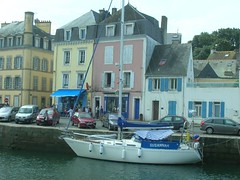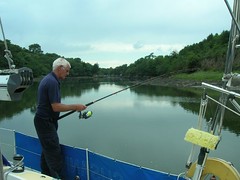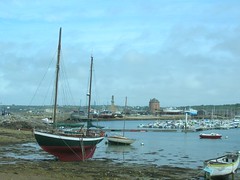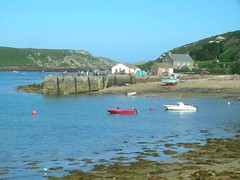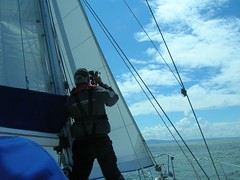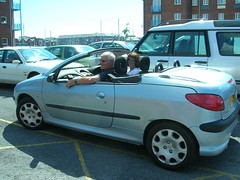WEDNESDAY 11 JULY 2007
 |
| Tresco |
PADSTOW TO NEW GRIMSBY SOUND, THE ISLES OF SCILLY
Another early morning – we left Padstow at 6.15, having moved onto a buoy in the river the night before. We managed to sail about 30 miles and then the wind was on the nose again so we motor sailed. It was lovely and sunny most of the way, but began to drizzle as we anchored in New Grimsby Sound. Just as we arrived in the Scillies, a puffin flew past the boat.
WILDLIFE: Puffin, guillemots, razorbills
THURSDAY 12 JULY 2007
TRESCO ISLAND
The forecast was for drizzle, fog and rain, but we actually had a little, if weak, sunshine. We took the dinghy ashore to Tresco and went to the Abbey Garden. The world famous gardens were created by Augustus Smith, who came from Ashlyns in Berkhamsted. Both Roger and I were brought up in Berkhamsted and went to Ashlyns School. We had a picnic in the gardens where the birds were extremely friendly and even managed to steal some of Roger’s food – something no one else has ever managed to do!
FRIDAY 13 JULY 2007
NEW GRIMSBY SOUND - ROGER’S BLOG : Force 8, New Grimsby Sound, The Scillies.
Riding to anchor in a F8 with lashing rain and mist, albeit quite comfortably, gave us the opportunity to reflect on some of the systems and equipment which we have added to Susannah in preparation for a long term live-aboard cruise to the Med.
First, a few words about New Grimsby Sound, described by Tom Cunliff as the best all weather anchorage in the Scillies. In all but a north-westerly, this certainly must be true with good holding , excellent shelter and short dinghy hops to either Tresco or Brhyer, both of which have surprisingly well stocked stores. We even managed to rent a DVD from the shop on Tresco and watched it on our laptop via a small inverter; the only problem being returning it as the gale makes dinghying a somewhat risky business.
Of course, for thrifty live-aboards, one of the great attractions of anchoring is the avoidance of the marina cash box or the harbour master collecting mooring fees (usually at some unsocial hour in the early morning). In this respect New Grimsby Sound is still a good option despite the increase in the number of visitors moorings – the entire area south of Hangman’s Rock is now full of them – there remains room for a few yachts to swing to anchor south west of Cromwell’s Castle. If the admittedly limited delights of Tresco or Brhyer pale, it is possible to catch the ferry to St Mary’s or other islands (last year in more settled conditions Sheila and I canoed in our blow-up canoe). In short, I do not understand why so many visiting yachts make straight for St Mary’s with its less than perfect shelter and relatively expensive moorings.
This morning, surprisingly, we appeared to run out of water. I say surprisingly because we had run our Echo2tec water-maker during the passage from Padstow and topped up our 24 gallon tank. Normally, we find that with a couple of showers each our water lasts for about five days rather than three! However, the lack of water was not a problem, we simply started our engine (enough revs to balance the water-maker’s huge amperage draw) in reverse gear so as not to polish our cylinders. After 30 minutes the water tank breather overflowed, indicating a full tank. The water-maker would have only put in about 4 litres during this time so the tank could not have been empty in the first place. The problem is probably an airlock in the system; further investigation awaits.
We decided to equip Susannah with a water-maker for two reasons; our tank is relatively small and the installation of a second tank would take up valuable storage space and add considerable weight. The second reason relates back to a delivery trip we did a couple of years ago from Greece to Milford Haven when we were shocked by the cost of marinas in the western Med and did not want to be forced into these cash sinks merely to take on water. Our research, carried out at the Southampton boat show, revealed that there are basically two types of water-maker on the market; those which create a relatively modest amperage draw of around 5 amps and those which require a much larger electrical supply of 20 amps or more. The disadvantage of the ones with a more modest draw is that they comprise a more complicated technology with more to go wrong. Being somewhat technically challenged I decided to go for the simpler, but high amperage type, accepting that we would only run the machine with the boat engine producing a copious supply of amps. We further narrowed down our choice by rejecting models with complicated add-ons such as automatic testing systems to inform you as to when it is safe to divert the processed sea water into the ship’s tank. In place of such a system with the potential for technological failure, I simply wait till water is being produced and take a sample in a glass and give it to Sheila. If she pulls a face somewhat reminiscent of the puckered back end of a donkey and exclaims that it tastes like shit I refrain from diverting it into the tank!
When we purchased Susannah some four years ago she was an extremely well finished example of a Colvic Countess 37, a tribute to the skill of Ron Weedon, her first owner, who had expertly fitted out the Colvic hull with very attractive English Light Oak which had come from trees blown down during the 1987 hurricane. However, she was equipped for day sailing rather than live-aboard blue-water cruising and it took four years of fairly sustained effort to convert her into a comfortable and self-sufficient cruiser. One item, purchased from West Marine, which greatly improves comfort at anchor in conditions such as these is the “Rock and Roll, Anti Roll Device” or as we prefer to call it the “flopper stopper”. This is simply a stainless steel plate hinged in the middle which is suspended from the end of the boom or spinnaker pole at right angles to the boat and is immersed at a depth of three to four meters. On the up roll the plate opens and dampens the roll. We are sitting at anchor in a force 8 and are able to leave glasses, computers etc on the salon table in complete confidence that they will not slide off. In short we find that the flopper stopper gives our monohull multihull anchoring characteristics. We hope that this bit of kit will increase our enthusiasm for anchoring and help avoid those horrendous Mediterranean marina bills.
One area where Susannah was sadly lacking when we purchased her was her 12 volt system; she simply had two 100 amp hour batteries, one dedicated for engine starting and the other for the domestic systems. This meant that the small and poorly insulated fridge could not be safely run without the engine and that ice was not constantly available for Sheila’s gin and tonics. We decided to redesign the 12 volt electrical system and install a 240 volt shore-power system complete with a three phase smart charger. Using Nigel Calder’s Mechanical and Electrical Manual as our guide and mentor we conducted an assessment of our daily electrical needs in amp hours. The survey revealed two items with relatively large electrically draws; the fridge (about 50 amp hours per day) and the autohelm (variable draw depending on sea state, wind and sail trim, but likely to be relatively high).
We decided to adopt conservation measures in relation to both items. The autohelm was simply taken out of the electrical equation by purchasing and installing a hydrovane wind vane steering system (we call ours Humphrey). We chose the hydrovane over other systems as it seems to us to possess two distinct advantages over other wind vanes; it does not necessitate lines criss- crossing the cockpit – a major factor given that the Countess is a centre cockpit boat – and it has an auxiliary rudder which could be used as an emergency steering device. The hydrovane , in my opinion is the single best addition we have made to Susannah, it holds a course better than any helmsman in any wind conditions and is of extremely rugged construction, something that cannot be said of the rest of the crew.
As regards the fridge, I initially suggested that we managed without constant ice-making. After the near divorce, we ripped out the existing box and compressor and re-equipped with a larger box, four inch thick insulation, a new water-cooled compressor (we expect ambient air temperature in the Med to be so high as to make an air cooled compressor rather inefficient) with Isotherm’s self pumping water cooling system and automatic holding plate. This combination has successfully reduced our fridge generated amperage draw from 50 amp hours per day to approximately 10 (in UK conditions). All this cost about £3,000 and three months of hard work. However, we now simply leave the fridge constantly on without worrying about it and Sheila can have a constant supply of iced gin and tonic.
Another, less expensive, conservation measure was to install a solar powered garden light (purchased from B and Q) as an anchor light. This achieves a saving of 8 amp hours per night – every little helps.
Even allowing for the above conservation measures our electrical needs survey revealed that Susannah required an average of 100 amp hours per day. Using the formulas in the Nigel Calder book this meant that we would need a domestic battery bank of about 400 amp hours in order to ensure that batteries are never discharged below 50% and that the fudge factor; an allowance for aging batteries, is catered for.
On the input side of the equation we upsized our alternator and fitted an Adverc battery management system which ensures that maximum amperage is put into the battery bank without ever overcharging and so gassing the batteries. If we were to rely on engine running alone to charge the batteries this system would be adequate. However, we intend to spend a lot of time at anchor and running the engine in this situation is far from ideal. First there is the peace and comfort of the anchorage to consider; after-all no-one appreciates a noisy smelly diesel running for a couple of hours every day. Secondly, as we all know, running an engine without load damages it while running it under load is likely to put extra strain on ground tackle or even break it out. A fundamental choice had to be made here between an engine driven generator (another engine to maintain!) or self- sufficient wind and solar panels. We opted for wind and solar panels, fitting Eclectic Energies D400 wind generator (which as I am writing this is pumping in 7 amps) and two 50 watt (i.e. maximum theoretical input) solar panels. Given wind and/or sun this equipment enables us to run our fridge and other electrical equipment without depleting the batteries. We never turn the fridge off or use the engine specifically for charging and yet our batteries are nearly always fully charged.


